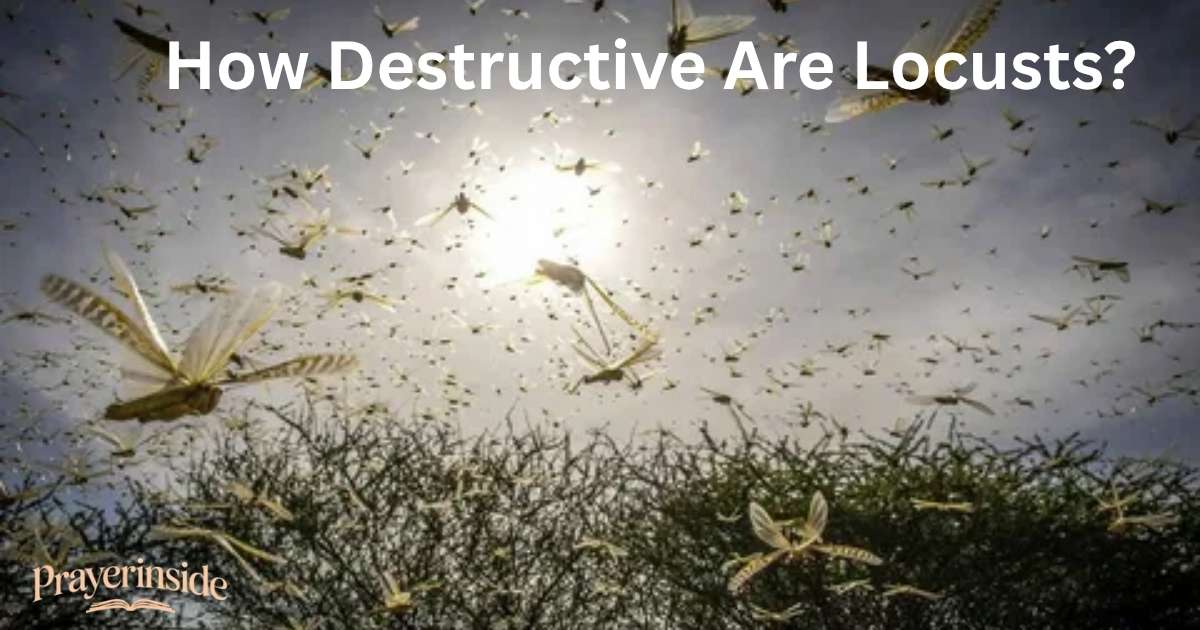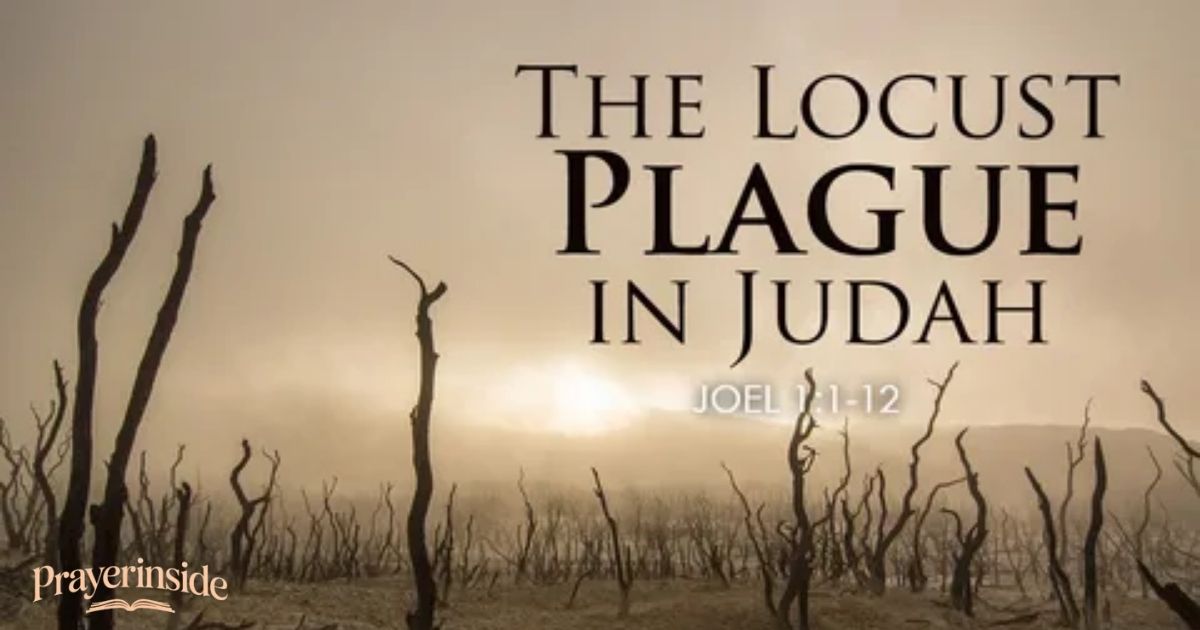Locusts in the Bible show how God uses nature to speak to people. When we read about locusts in the Bible, we see stories of warning, judgment, and hope. The locust in the Bible isn’t just an insect. It’s a sign of God’s power and His call for repentance. In Exodus, Joel, and other books, these tiny creatures bring great change.
The locusts Bible stories remind us that nothing can stand against God’s will. When the land was filled with these swarming insects, people saw the cost of pride and sin. Yet, the same God who sent the plague also promised healing. The locusts in the Bible teach us about loss and renewal, destruction and restoration. Through every plague, God’s mercy and purpose shine through.
What does the Bible say about locusts?
Locusts in the Bible appear many times as signs of God’s power and warning. In Exodus 10, a great plague of locusts covered Egypt and showed Pharaoh that the LORD rules over all. These insects destroyed every green thing, leaving nothing behind. The locust Bible story teaches how pride and sin can bring devastation when people ignore God’s command.
The prophet Joel also wrote about locusts in the Bible. He described the swarming locust, great locust, young locust, and cutting locust eating everything in their path. These verses in Joel 1 and Joel 2 show that God’s judgment can come through nature. Yet, Joel promised restoration if people turned back to God. The locusts Bible message warns but also gives hope.
In Proverbs 30, locusts in the Bible show wisdom and unity. They have no king, yet they move together in order. In Leviticus 11, the locust Bible verses even allow people to eat locusts, katydids, crickets, and grasshoppers. These small details remind us that God cares about every part of creation. Even insects like locusts have a purpose in His plan.
From Revelation 9 to Nahum 3, the locusts Bible stories reveal both fear and faith. Sometimes they picture spiritual warfare, divine judgment, or even demonic locusts rising from the Abyss. Other times they show repentance, restoration, and refuge in God. Through every story of locusts in the Bible, we see His sovereignty, grace, and mercy. God uses even the smallest creature to teach great lessons.
How Destructive Are Locusts?

Locusts in the Bible are shown as one of the most destructive insects on earth. In Exodus 10, a plague of locusts covered Egypt until the land turned dark. These creatures ate every plant, fruit, and tree left after the hail. Nothing green survived. The locust Bible story shows how God used them to humble Pharaoh and reveal His mighty power.
A swarming locust can destroy fields faster than fire. One swarm may cover hundreds of miles, filled with billions of grasshoppers. Each great locust and young locust eats its weight in plants every day. The cutting locust, hopping locust, and destroying locust leave behind only dust. These insects bring famine, ruin crops, and cause deep devastation across nations.
In Joel 1 and Joel 2, the locusts in the Bible are called God’s army. They move in ranks like soldiers, bringing destruction wherever they go. The prophet says the land looked like the Garden of Eden before them, but behind them lay waste. This image shows how quickly blessings can vanish when people turn from God.
Even today, scientists warn how real locust swarms still threaten food supplies. The locusts Bible message remains the same—God’s creation holds great power. He can use the smallest insects to remind us of our dependence on Him. The plague of locusts teaches about judgment, repentance, and restoration. When we turn back to God, He can heal what’s been lost.
Where Do We Find a Plague of Locusts in the Bible?
Locusts in the Bible appear in many books and passages of the Bible, showing up as both real events and powerful symbols. The first great plague of locusts is in Exodus 10, when God sent swarms over Egypt. The LORD used the locust Bible story to show His strength to Pharaoh, Moses, and Aaron. Every green plant was gone, and the land grew dark under the swarm.
We also find a massive locust plague in Joel 1 and Joel 2. The prophet Joel describes the great locust, young locust, cutting locust, hopping locust, and destroying locust. These insects ate everything, leaving nothing but devastation. Joel connected this disaster to the Day of the LORD, calling the people to repentance and return to God for restoration.
Other locusts Bible passages appear in Deuteronomy 28, 1 Kings 8, Psalms 78, and Psalms 105, where locusts represent divine judgment and covenant disobedience. In Nahum 3, they symbolize invading armies, while Proverbs 30 shows locusts in the Bible as examples of unity and wisdom. Even Leviticus 11 lists locusts, katydids, crickets, and grasshoppers among clean foods.
In the New Testament, Matthew 3 and Mark 1 tell how John the Baptist ate locusts and wild honey in the wilderness. The final image appears in Revelation 9, where demonic locusts rise from the Abyss at the sound of the fifth trumpet. These spiritual locusts bring torment, showing the power of divine judgment in the apocalypse.
Locust in the Bible

Locusts in the Bible show God’s power, judgment, and restoration. The plague of locusts brought devastation to Egypt, Israel, and many nations. Yet God also used locusts to teach repentance and dependence on Him.
- In Exodus 10, Moses, Aaron, and Pharaoh saw a plague of locusts cover Egypt. These insects ate every green thing, proving the sovereignty of God and His power to humble kings.
- The locust Bible story in Joel 1 shows four kinds of locusts—swarming locust, great locust, young locust, and cutting locust—as symbols of divine judgment and calls for national repentance.
- Joel 2 describes the hopping locust and destroying locust like an army. The land turns from Eden’s beauty to wilderness, showing creation and de-creation through the judgment of God.
- In Leviticus 11, God lists locusts, katydids, crickets, and grasshoppers among clean foods, showing His attention to even small insects and teaching obedience through dietary laws.
- Proverbs 30 says locusts have no king, yet they move in ranks. This locusts Bible verse teaches unity, order, and wisdom from God through simple creatures.
- Psalms 78 recalls when God sent grasshoppers and locusts over Egypt as part of the Ten Plagues, displaying His sovereignty and divine wrath against disobedience.
- Psalms 105 reminds readers that God (YHWH) used locusts to fulfill His covenant promises, freeing the Israelites from Egyptian slavery through signs, wonders, and plagues.
- In Deuteronomy 28, locusts appear as a curse for covenant disobedience. When people turn from God, the plague of locusts destroys their crops and prosperity.
- 1 Kings 8 mentions locusts in Solomon’s prayer. If famine or pestilence comes, the people must turn and pray for forgiveness and deliverance from God’s judgment.
- Isaiah 33 compares nations to locusts that strip the land. This image warns of devastation from sin and calls for repentance before the Day of the LORD.
- Nahum 3 uses locusts in the Bible to describe Assyrians and their destruction. They swarm, consume, and vanish, symbolizing divine judgment on pride and human frailty.
- Jeremiah speaks of armies like locusts, showing devastation that comes through sin and rebellion. The image mirrors Joel’s vision of the Assyrian invasion as a warning to nations.
- Matthew 3 and Mark 1 describe John the Baptist eating locusts and wild honey. His simple diet shows dependence on God, obedience, and humility before The Almighty (El Shaddai).
- In Revelation 9, demonic locusts rise from the Abyss at the fifth trumpet. They torment people, symbolizing spiritual warfare, divine judgment, and the coming apocalypse.
- The locust Bible image of crowns of gold and human faces in Revelation shows how sin can twist creation, pointing to the need for salvation through Jesus Christ.
- Mike Leake, a pastor from Neosho, Missouri, explains in his article Borrowed Light that locusts in the Bible represent destruction, repentance, and restoration through God’s grace.
- The theologian Ligon Duncan said that in Exodus 10, God was “de-creating Egypt.” The plague of locusts reversed blessings of creation, proving the sovereignty of God.
- The locusts Bible stories remind us that God can turn devastation into redemption. When we repent, He brings restoration of years that the locusts have eaten.
- Every locust in the Bible reveals a truth—God’s power over creation, human dependence, and the hope of deliverance for those who seek refuge in God.
- The locusts in the Bible teach that repentance leads to restoration, destruction can become redemption, and faith in Jesus Christ brings lasting salvation and hope amid devastation.
The message of locusts in the Bible remains timeless. Through stories of judgment, sin, and restoration, we learn to humble ourselves, seek refuge in Jesus, and trust God’s mercy.
What Is the Meaning for Us Today?
Locusts in the Bible still speak powerful lessons for us today. Each plague of locusts shows that God rules over nature and history. When people ignore Him, blessings can turn to devastation. The locust Bible stories teach us humility, reminding us that even small insects can bring nations to their knees. Like Pharaoh in Egypt, we learn that pride leads to loss, but obedience brings peace.
In Joel 2, God promises, “I will restore to you the years the locusts have eaten.” That verse shows His heart of restoration and grace. Even when life feels ruined, God can rebuild. The locusts Bible message isn’t just about judgment; it’s about redemption and hope. He turns destruction into growth and devastation into new beginnings.
The locusts in the Bible also call us to repentance. When disaster strikes—whether famine, pestilence, or hardship—it’s a time to turn back to the LORD. Joel, Isaiah, and Jeremiah warned their people to seek refuge in God before it was too late. The Day of the LORD will come, but those who trust in Jesus Christ will find salvation and deliverance.
Today, the same God (YHWH) who judged Egypt and restored Israel invites us to trust Him. When we face loss, He offers forgiveness and mercy. The locusts Bible message reminds us that no ruin lasts forever. Through repentance, faith, and dependence on God, He restores the years the swarming locust, great locust, and destroying locust have taken.
Also Read : Happy Bible Verses That Will Brighten Your Day and Lift Your Spirit
Conclusion
Locusts in the Bible remind us that God uses even small creatures to teach big lessons. The biblical locust shows both judgment and mercy. When people sinned, the locusts in the Bible brought destruction. Yet, when they turned back to God, He brought healing and restoration. The locust Bible stories show that nothing escapes God’s control. Every plague had a purpose to call hearts to repentance and trust in Him again.
So, what are locusts in the Bible really about? They are not just insects. They are symbols of divine warning, repentance, and renewal. The locusts Bible stories teach us to depend on God in times of loss. Even after the biblical locust destroyed everything, God promised to restore what was lost. The locusts in the Bible reveal His power, love, and endless grace.

